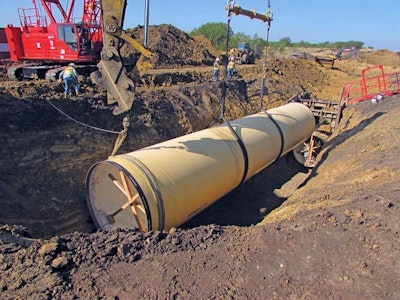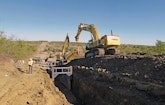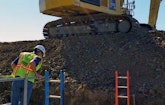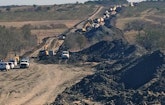
The Tarrant Regional Water District is building a massive new 150-mile-long water supply pipeline in north Texas that will double the district’s transmission capacity, but delays have already pushed the project’s targeted completion date back 12 years.
The $2.3 billion project was originally slated for completion by 2018, but the target date keeps receding. Now it’s about 2030, and it could wind up taking longer. That’s no reason to complain, however; it’s actually an accomplishment.
That’s because construction hang-ups haven’t delayed the project. Instead, conservation has, says David Marshall, director of Engineering and Operations Coordination for the water district. And regionwide teamwork involving the water district and municipalities in the greater Dallas-Fort Worth metro area — where most of the people served by TRWD live and work — has made that conservation ethic far more effective than it might have been otherwise.
Along the way, the water district has been undergoing steady infrastructure improvement and now has begun to develop a systematic asset management program so that it can move beyond reactive maintenance, says Marshall.
The water district serves an 11-county slice of north Texas centered on the Fort Worth-Arlington area. Established as Tarrant County Water Improvement District No. 1 by the state Legislature in 1924, the water district was started following severe flooding two years earlier in Fort Worth. By 1930, it took on greater water supply responsibilities, supplying the City of Fort Worth with raw water to supplant a rapidly depleting supply of groundwater.
Initially the district took raw water from two reservoirs upstream on the West Fork River. In the decades since, the region has grown and the water district with it. The Dallas-Fort Worth metro area “has grown dramatically,” Marshall says — on the order of 1.5 to 2 percent a year over the last 40 years.
While flood control remains a significant responsibility for the district, supplying water has become the largest component of its mission: “Our water supplier enterprise fund is four times the budget of our flood control operation,” notes Marshall.
About 1.9 million people rely on TRWD water to drink, bathe, water their gardens and more, but the district’s direct customers are more than 30 municipalities and similar entities. The lion’s share of its water — 92 percent — is used in Tarrant County, with about two-thirds of that going to Fort Worth.
Over the years, the district has tapped into several new reservoirs; today, its first two, Eagle Mountain Lake and Bridgeport Lake, supply only about 15 percent of the water the district transmits, Marshall says.
Wet and dry
Disastrous flooding in the 1920s helped spark creation of the water district, and flood prevention remains an important part of its job. But in recent decades it’s faced challenges from the opposite side of the coin: drought.
Severe drought conditions have made keeping the TRWD’s reservoir water supplies reliably available a continuing critical task. And because it depends so heavily on those reservoirs, the district has been required to make sure it can rely on the transmission infrastructure, too.
Of the existing 180 miles of pipeline, about 150 miles are constructed with prestressed cast concrete pipe. Back in the late 1980s and early ’90s, the district, like many other water utilities, encountered problems with prestressed concrete breaking down too soon.
A users group of water utilities convened with the industry’s manufacturers and over time got to the bottom of the problem: Transient water hammer pressure would crack the pipeline’s outer mortar coating, exposing reinforcing wire in the pipe’s structure. The wire tended to go brittle with exposure to certain naturally occurring chemicals.
TRWD was especially vulnerable to the corrosion that was responsible. “Texas soils are very aggressive,” Marshall says.
Systematic replacement
Since coming to understand that problem in detail, TRWD has been systematically replacing problem segments of pipe in its system with newer varieties of the prestressed cast concrete redesigned to reduce or eliminate the sources of decay.
“We replace anywhere from 10 to 15 segments of pipe a year,” Marshall says, noting they did much more in the earlier years after the concrete pipe specs were rewritten. These days the focus is on the pipes that pose the biggest risk over the next five to 10 years.
TRWD maintenance programs focus on additional priorities as well, such as ensuring air vacuum valves are “100 percent reliable,” says Marshall. “We also monitor pump efficiencies — once our pumps drop about 5 percent, we rebuild them.”
The reason is pretty straightforward: Less efficient pumps use more energy — and the energy demand TRWD makes on the grid so it can move water through the DFW metro area puts it among the top 1,000 energy users in the Lone Star State. “Last year we spent about $26 million on energy,” he says.
The district is also beginning to develop a stronger system of asset management that seeks to bring a sharper analysis to estimating when repairs or replacement of infrastructure is called for. That’s still in the early stages, Marshall says.
Doubling capacity
Reliability remains a continuing objective, and that’s why TRWD is now working to nearly double its transmission capacity with new lines and additional water sources.
When complete, the $2.3 billion Integrated Pipeline project will give the system another 150 miles of transmission line, connecting to Cedar Creek and Richland-Chambers reservoirs as well as Lake Palestine and Lake Benbrook. The additional 350 mgd of water will more than double the water available to the region where the district is located.
The project is being undertaken as a partnership between TRWD and the City of Dallas, which is outside the water district’s own territory. The line is to include 95 miles of 108-inch-diameter pipe, and 55 miles of 84-inch pipe.
By sharing resources, Marshall says, the two entities estimate they’ve cut about a half billion dollars in capital costs and more than $1 billion in energy costs over the life of the pipeline.
To date, 15 miles of pipe have been completed so far and the first round of bidding covered 25 miles. One surprise, Marshall says, has been that steel pipe is becoming more competitive, so the initial portions of the line are being built with steel instead of the prestressed concrete that has until now been the old standby for the utility.
The first operational use of the line is expected to begin in 2017 with connection to the Richland-Chambers reservoir.
Conserving water
Even as TRWD and its partner, Dallas, have been planning and beginning construction on the new pipeline, the two entities, along with TRWD’s customer municipalities, have been working together to actually reduce the need for the line’s added capacity. That’s been especially important because of the drought the region has endured for several years now.
The district has been working with landscapers, plant suppliers, irrigators and homeowners to encourage a transition away from lush “English manor” style yards to a lawn aesthetic appropriate for the dryer climate of the area. “This is the grand prairie, and our yards should reflect that,” Marshall says.
Other measures have helped increase water reuse — essentially, relying on treated wastewater returned to the Trinity River. A wetland 100 miles downstream from the metro area, under the TRWD’s oversight, has helped retain the treated effluent for at least seven days before it is discharged into a reservoir, where it remains for at least six months.
“Then it just becomes reservoir water,” says Marshall. “Anything left becomes biologically mitigated, so it becomes raw water for our customers.”
As a result, at least 15 percent of the district’s water supply is from reuse, and in 2014, the actual reused water was closer to 20 percent, he says.
The district has seen its demand curve take a much flatter path than the area’s growth — another sign that its conservation strategies are working. “We’re adding over 100 people a day to our system — 40,000 people a year,” Marshall says.
For instance, in the last decade, Fort Worth has grown by around 40 percent. In the process, the city developed a denser, more urban feel that has been an asset, with high-rises and condominiums as well as a thriving night life that have made the area more attractive.
“But their water demands have only grown by 6 percent,” he says. “Our demand reductions have just been far greater than I anticipated. We’re estimating our demand is down at least 30 percent based on the conservation program.”
The lower demand has thus slowed down the Integrated Pipeline project so that it keeps pace more closely with the actual increase in demand.
Through it all, the district has sought to keep its eye on the big picture. As examples, he points to projects such as a linear park that makes an amenity out of levee areas in the Fort Worth floodway and another 400-acre park at the district’s Eagle Mountain reservoir.
“We’re not just bringing water here reliably, but also trying to enhance the quality of life with the projects we do.”










